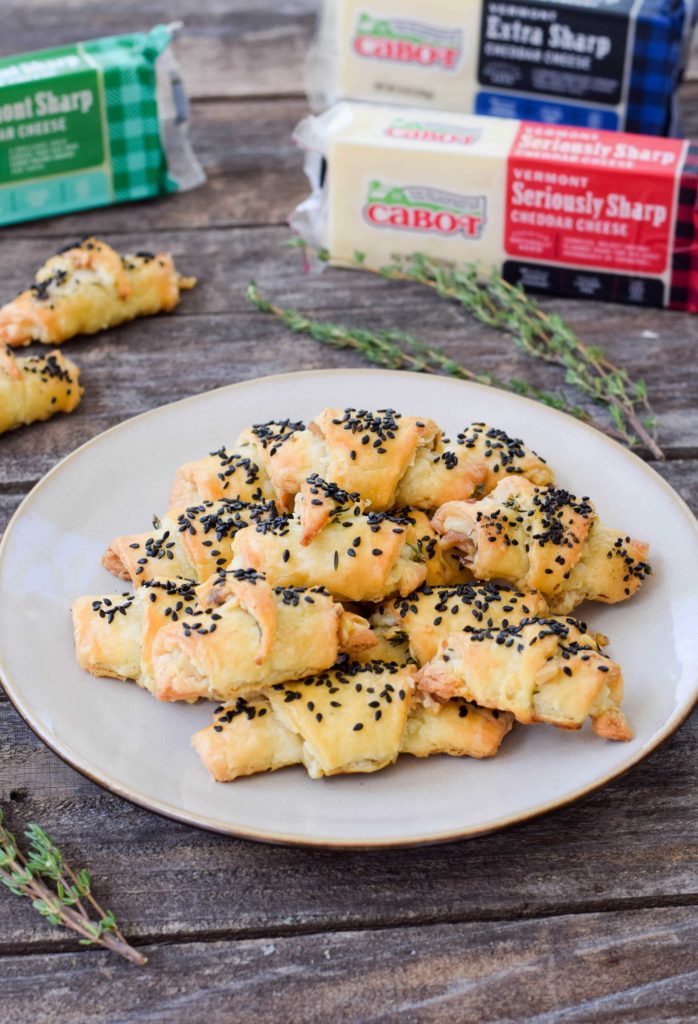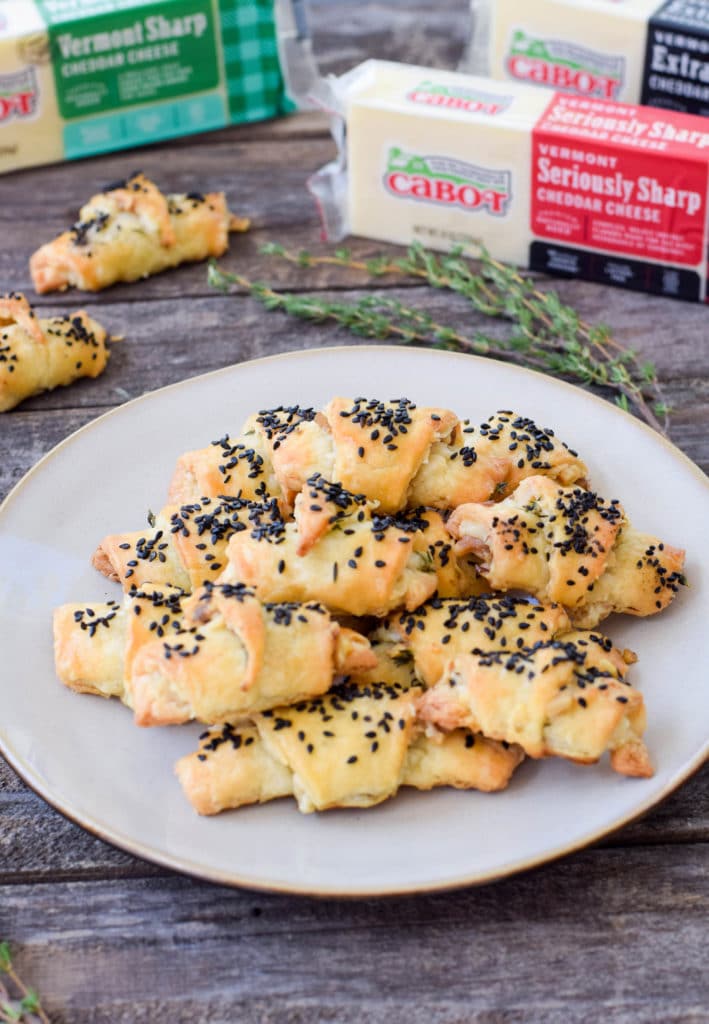Thanks to Cabot Cheese for sponsoring this Shavuot post. All opinions stated herein are entirely my own. Enjoy this recipe for savory rugelach made with Cabot Cheddar and chopped walnuts.
Coming fifty days after Passover, Shavuot – which means “weeks” in Hebrew – commemorates the day God gave the Torah to the nation of Israel at Mount Sinai. There are no specific requirements for celebrating Shavuot — unlike the many required observances for Passover, for example — but there are many minhagim, or customs, associated with the joyous festival. My favorite Shavuot tradition is to eat dairy foods.
As always, there are several different explanation of why it is traditional to eat dairy on Shavuot. First, Shavuot usually falls in the spring – this year, Shavuot begins later than usual on June 8 – which was when, in pre-industrial times, cows would be giving birth to calves and farmers would have a ready supply of milk. For the same reason, spring was the traditional time of year for cheese-making. But beyond this very practical explanation, there are many religious ones as well.
The story I always heard about why we eat dairy on Shavuot is that, once the Israelites received the Torah and learned about the kosher laws, they could not eat any of their meat, which would not have been butchered properly. So they simply ate dairy. There are other explanations too, such as that we eat dairy to symbolize how the Israelites were promised a “land of milk and honey.”
Whatever the reason, you don’t have to ask me twice to celebrate a holiday by eating cheese, especially award-winning Cabot cheddar. Cabot’s classic cheddars have a smooth taste with just the right amount of bite and, what’s more, Cabot Cheese is a company that does business the right way. A certified B Corporation, Cabot Cheese is a co-operative owned by farm families throughout New England & New York. That means that 100% of profits go back to the farmers. They have been doing business this way for 100 years! Yes, 2019 is Cabot Cheese’s 100th anniversary as a cooperative.
I have made many dairy recipes for Shavuot over the years from cheesecake to cheese blintzes. This year, I wanted to make something savory for a change using classic Cabot cheddar. I decided to make a savory version of one of Jewish cuisine’s best known cookies: rugelach.
Rugelach is perfect for Shavuot because the dough contains not only butter but also cream cheese – yes, it doubles down on the dairy. After some thought, I decided to fill my savory rugelach with one of Cabot’s classic cheddars, some chopped walnuts – chopped nuts being a common filling for rugelach – and a sprinking of fresh thyme.
All I can say is yum. These savory rugelach are akin to a flaky, crumbly, cheese biscuit, like something you might nibble on with drinks at an English country manor. The thyme is absolutely critical here – do not be tempted to omit it. Or at least use a different fresh herb such as rosemary or oregano. But you need a hint of something vegetal and herbaceous to counterbalance the sharp cheese and astringent walnuts.
I also topped my cheddar rugelach with nigella seeds, which adds an oniony note. If you cannot find nigella seeds or don’t care for them, try sesame or poppy seeds or just a sprinkling of flaky sea salt.
Whether it’s for Shavuot or just for an upcoming cocktail party, I hope you give these Cheddar and Walnut Rugelach a try. I think you will find them to be a delightfully savory take on the classic Jewish pastry.
Ingredients
- 1 cup all-purpose flour
- 1/2 tsp salt
- 4 oz cold, unsalted butter, cut into cubes
- 4 oz cold cream cheese, cut into cubes
- 2 cups grated sharp or extra sharp Cabot cheddar
- 1 cup finely chopped walnuts
- 2 TB thyme leaves stripped off the stem
- 1 egg beaten with 1 TB water
- Nigella, sesame or poppy seeds for sprinkling
Instructions
- Place the flour and salt in the bowl of a food processor. Add the butter and cream cheese and pulse several times until well broken up.
- Process the dough in short intervals, stopping to scrape down the sides as necessary, until large clumps of dough form. Do not let dough form a ball.
- Turn the dough out onto a cutting board and gently knead it into a ball.
- Divide the dough in two equal pieces, flatten to about 3/4 inch thick, and wrap each portion in plastic wrap. Refrigerate for at least three hours and up to two days.
- Preheat the oven to 350 degrees and line two sheet pans with parchment paper or silicone baking mats.
- Take the dough out of the refrigerator, and let it sit for 5 minutes to reduce cracking. (Work with only one portion of dough at a time, as it will soften quickly and become difficult to shape.)
- On a well floured surface, roll out the dough into a 12-inch circle. If the edges of your circle are ragged, trim them with a knife.
- Leaving a narrow plain edge, spread 1 cup of grated cheese over the dough.
- Evenly sprinkle 1/2 cup of the walnuts over the cheese avoiding the center of the circle.
- Sprinkle 1 TB of thyme over the circle.
- As if cutting a pizza, cut the dough round into sixths, and then halve each portion on until you have 12 wedge-shaped pieces.
- Starting at the outside edge, carefully roll up each wedge into a crescent, and place on the parchment-lined pan, with the end point on the bottom side.
- Chill the formed cookies for fifteen to twenty minutes, prior to baking. Repeat process with second disk of dough.
- When ready to bake, lightly brush the tops with the egg wash, and sprinkle them with seeds. if using.
- Bake for twenty to twenty-five minutes, until golden.
- Let cool on the pan for five minutes, then remove to a cooling rack.











Would almond flour work as well?
Hi Katie! Thanks for your question. I do not know if almond flour would work. I do not work with it myself as my daughter has an almond allergy. If you need the recipe to be gluten-free, I would suggest a gluten-free flour blend, such as the one made my King Arthur Flour.